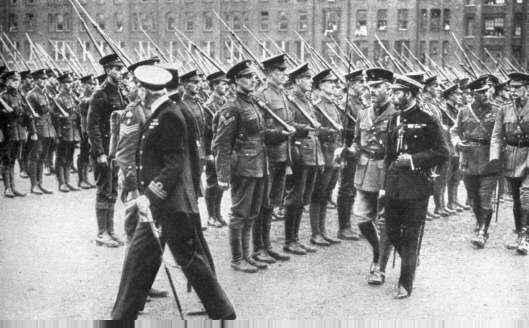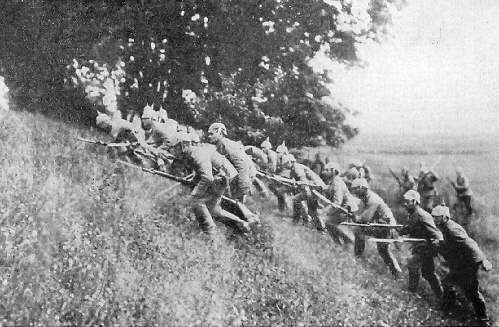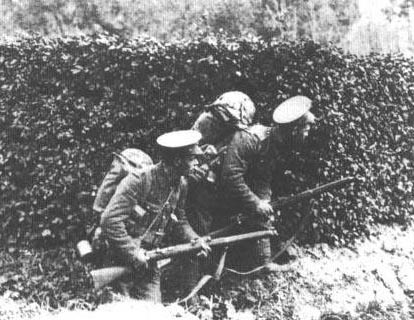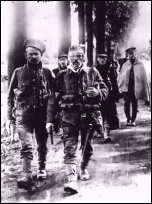 | ||
| Battle of the Frontiers - Charleroi and Mons |
| World War One - The War To End All Wars |
Coming Soon

First Action for the BEF

The British Expedition Force (BEF) was small in number compared to the European armies of the day, yet it was highly trained and very professional. On 4 August, Britain declared war and bound by her promise to France the fate of the BEF had been declared. By 22 August, 4 infantry divisions and one cavalry division had disembarked for France. Just as pre-war plans had dictated they had taken up position just across the Belgian border, several miles south of the Mons, on the left of the Allied lines.

The German army was on the move and things were going well. Just as Schlieffen's plan had dictated, the might of Germany's army was on the right flank. It was poring through the leaky Belgian defenses. The German 1st Army under von Kluck was moving on Ath and Mons and they seemed unstoppable. British commanders sent out cavalry and observation plans to scout the situation and quickly became convinced that the German Army en mass was headed for the Mons.

Daybreak 22 August: Major Tom Bridges cavalry commander of C Squadron of the 4th Royal Irish Dragoon Guards sent two patrols north towards Soignies and first contact was made with the Germans. C Squadron set up recon along the road from Maisieres. There, 4 German cavalrymen of the 2nd Kuirassiers emerged. Realizing the Irish had spotted them, they began to flee in the direction of Casteau. Led by Captain Hornby 1st Troop took chase, and was quickly followed by 4th Troop. Near Chateau of Ghislain, a shot rang out. It was Corporal E. Thomas of the 4th Troop and he had fired Britains first volley of the war. He was only 14 years old but had already served in the Indian Army. Hornby rallied his men and charged the fleeing Germans. After the charge Hornby returned with his sword drawn showing blood and boasting stories of hot pursuit.
The infantry of the BEF had begun to hastily dig rough entrenchments in a line of defense along the Mons canal. The I corps was to the east echeloned back to the northeast. II corps was thinly stretched along the canal. It was decided that if fighting became to fierce along the canal, II Corps would evacuate Mons and fall back to a defensive position among the slag heaps to the south. The Germans it seems; may not have known the BEF were in the area. Even after skirmishes on August 22 they still had not learned the size of British forces.
Dawn 23 August: The day started misty and raining and around 6:00 AM Field Marshal Sir John French called a meeting with Generals Haig, Allenby, and Smith-Dorrien to discuss shoring up the line around the canal, and the preparation of bridges for demolition. French knew the British positions were dangerously bare due to a turn in the canal leaving three sides exposed. 5th division of the BEF was not fairing much better. Their defensive perimeter was a logistical nightmare. Ditches, half destroyed buildings, poor roads, and high slag heaps made it difficult to maneuver. The Germans were having much the same problem with the terrain and this was slowing down their advance.
9:00 AM august 23: German field artillery held the high ground and to German command it was obvious where the brunt of the attack must take place. It would concentrate on the thinly defended canal area held by II Corps of the BEF. The German guns opened up and the first to feel their fury were the men of the 4th Middlesex and 4th Royal Fusiliers. Next the infantry attacks. Men of the German IX Korps form across the canal began to advance and this increased in intensity all around the salient from Obourg to Nimy. Now the 84th regiment from Schleswig charged the British positions at Nimy. They were savagely mauled by the withering musketry of the BEF.
The German III Korps had now joined the action and the attack had moved about 2 miles west of Mons. The Scottish Fusiliers on the north bank of the canal were withdrawn.
The Germans began to cautiously move ahead until they were about 250 yards from the bridge. There the well - trained riflemen of the BEF brought the Germans to a halt.

While the accurate rifle fire of the BEF was holding up III Korps, another drama was being played out just to the west. The elite Brandenburg Grenadiers were moving forward against the men from West Kent and the Scottish Borderers on the canal bank. It looked like nothing could stop them until near the village of Tertre a labyrinth of boggy dikes, and wire fences held them up long enough for the Kents, and Scots to catch them in a crossfire.
August 22, 12:00 PM: Having been bloodied by the tremendous volume of BEF rifle fire, the German attacks along the straights of the canal became more cautious. Despite all this, German artillery fire continued and by early afternoon the BEF brigades on the west were forced to pull back. The western flank of the BEF was now in full retreat and the Scottish Fusiliers who had earlier been forced to escape from the north bank of the canal were feeling the heat. Near the village of Frameries three bridges were to be destroyed. Only one bridge was blown due to the lack of detonators to set off the charges. The Germans poured across the undamaged bridges and set chase to the Scots.
Early afternoon 22 August: Back at the canal the situation was desperate. Shortly after noon the Germans were successful at passing the canal just west of Obourg, and now they had command of the village railway station. Here the mass formations that had made an easy target for British riflemen were broken up into smaller squads and dispersed accordingly. The Middlesex and Royal Irish were in dire straights. They had been under surveillance from the high ground to the north by artillery spotters, and were now being threatened by German patrols pushing through Mons advancing to the rear.

Middle to late afternoon 22 August: The Middlesex and Royal Irish began to retreat, and just minutes earlier the Royal Fusiliers retreated from Nimy. Weather by divine intervention, or just shear luck the BEF experienced only about 100 causalities during the retreat allowing them to reform at Mons and move to the small village of Ciply.
Now the Germans were to close for all the bridges to be blown. At the Bridge of Nimy a Royal Engineer was taken prisoner and things looked grave. Demolition crews were trying to set the charges under a hail of German sniper fire. Smaller unites of men never received the order to retreat and fought to the last man as a sea of gray swallowed them. The German attack was in full force along the road into Nimy. BEF High Command tried to bring about some sense of order but it was to late. The men at the top of British command had lost control; now it was up to the officers and NCOs in the field to restore order. British High Command saw on this day a corps of NCOs and junior officers work a miracle in restoring a semblance of order out of chaos. Yet as the war progressed they refused to hear what they were telling them.
The Germans never exploited the successes of the day and night began to fall. Instead of continuing the attacks it is said that bugles were heard to blow cease-fire. News now reached the BEF That the French had lost Tournai and long columns of Germans had broken through. Sir John French now had no chose but to order a full withdrawal towards Cambrai

The men of the BEF could not believe the order, they felt they had fought the vaunted German Army superbly and given them what for. Reluctantly they followed orders; after all that is what a soldier does. The retreat began and the "Old Contemptibles" the men of the BEF would march and march until they met "Old Jerry" one more time on another battlefield.
|
|||||||||
|
|
|||||||||
|
|
|||||||||
| |||||||||